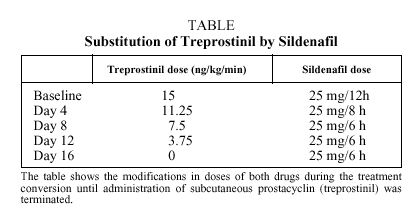Introduction
The treatment of pulmonary arterial hypertension (PHT) with prostacyclin in its different forms (intravenous, subcutaneous, inhaled, and oral) is effective from a clinical and functional point of view, although only intravenous prostacyclin (epoprostenol) has been shown to improve survival.1 Treprostinil is a stable form of prostacyclin administered in continuous subcutaneous infusion. The most common adverse effect of this drug is pain in the injection area. Although this pain is usually controllable, sometimes it means that treatment must be suspended.2
Sildenafil is a selective inhibitor of phosphodiesterase-5 (PDE-5) with pulmonary vasodilating effects. It has proven efficacy in diminishing pulmonary pressures in monotherapy and in combination with prostacyclin or nitric oxide.2,3 We report the case of a patient suffering from severe PHT associated with systemic lupus erythematosus (SLE). Treatment with sildenafil was substituted for treprostinil due to incapacitating pain in the area of injection.
Clinical Observations
A 25-year old woman with SLE was diagnosed with PHT with no response to a vasoreactivity test with epoprostenol. The patient suffered repeated effort-related syncopes once treatment with inhaled prostacyclin began. For this reason treatment with subcutaneous prostacyclin, at a dose of up to 15 ng/kg/min in continuous infusion, was started in January 2002. Until then she had been clinically stable (New York Heart Association [NYHA] type 2, 460 m on foot, 6-minute walking test). The patient reported intense abdominal pain near the injection site, however, as the dose increased. The pain could not be controlled with topical or oral medication (an antiinflammatory drug and gabapentin).
Treatment with sildenafil was started on compassionate grounds with consent from the patient and from the health authorities. The starting dose was 25 mg every 12 hours. Initially the same dose of subcutaneous prostacyclin was maintained. Every 4 days the subcutaneous prostacyclin dose was reduced and the dose of sildenafil was increased until a stable dose of 25 mg every 6 hours was reached (Table). The abdominal pain remitted as soon as treatment with subcutaneous prostacyclin was discontinued. The patient remained stable 3 months later (NYHA type 2, 475 m on foot, 6-minute walking test) with sildenafil therapy alone. During follow-up, the treatment dose was increased to 50 mg every 8 hours (50 mg dose every 6 hours was not tolerated due to headaches). The patient remained stable and 9 months after the change of medication her condition was classified as NYHA type 1 (510 m on foot, 6-minute walking test). No further relevant adverse effects were detected.
Discussion
Subcutaneous prostacyclin is effective in treating PHT in terms of short-term (3 months) clinical improvement2 and has recently received approval for clinical use. Injection site pain is the most common adverse side effect (85%) and although it is often controllable by topical or oral medication (paracetamol, antiinflammatory drugs, gabapentin, or corticosteroids), treatment must sometimes be suspended (in 8% of cases in a double-blind trial).
Sildenafil is a selective inhibitor of PDE-5. The decrease in the nitric oxide production rate and in guanosine 3'5'-monophosphate (cGMP) activity contributes to the development of PHT in the pulmonary bed. Nitric oxide, produced in the vascular endothelium, has a very short half-life and is a very strong pulmonary vasodilator by guanylate cyclase activation, through which cGMP is produced. cGMP is degraded by phosphodiesterases, of which there are 11 known types. PDE-5 selectively deactivates cGMP and is widely present in the cavernous bodies of the penis and in the vascular pulmonary bed. Selective inhibition of PDE-5 with sildenafil induces nitric oxide dependent vasodilation mainly in the aforementioned regions. This is the reason for its efficacy in treating erectile dysfunction and for its potential beneficial effect in PTH.
That oral sildenafil alone,4,5 combined with nitric oxide,3,4 or with inhaled prostacyclin5 causes vasodilation and a decrease in pulmonary pressure has been established experimentally. Although clinical experience is scarce, cases have been reported in which sildenafil was used to treat PHT, with clinically favorable outcome at a 3-month follow up.7,9 Empirically established doses have varied greatly.
In our patient, the uncontrollable pain caused by the treprostinil injection required suspension of that drug. Treatment with sildenafil alone was not only effective in preventing possible deterioration due to withdrawal of treprostinil, but also led to improved short- and mid-term outcome at 9 months. To our knowledge, no other cases of substitution of prostacyclin by sildenafilin monotherapy have been reported.
Although there is little experience with sildenafil, it may be useful in treating PHT. The efficacy of this drug alone and combined with prostacyclin and the determination of the optimal dose are being studied in multicenter trials.
Correspondence: Dr. P. Escribano Subías.
Unidad de Hipertensión Pulmonar, Insuficiencia Cardíaca y Trasplante
Cardíaco. Servicio de Cardiología. Hospital Universitario 12 de Octubre.
Ctra. de Andalucía, km 5,4. 28041 Madrid. España.
E-mail: med022585@saludalia.com
Manuscript received February 4, 2003.
Accepted for publication February 18, 2003.











